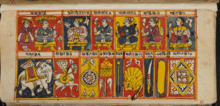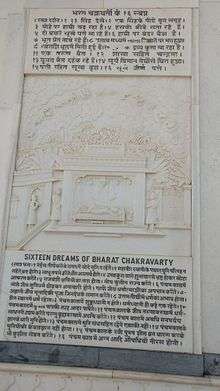Bharata chakravartin
Bharata is claimed to be the first chakravartin (universal emperor or possessor of chakra) of avasarpini (present half time cycle as per Jain cosmology) in Jain tradition. He was the eldest son of Rishabhanatha, the first tirthankara of Jainism. According to the Jains, the ancient name of India was named "Bhāratavarsha" or "Bhārata" or "Bharata-bhumi" after him. He had two sons from his chief-queen Subhadra named Arkakirti and Marichi. He is said to have conquered all the six parts of the world and to have engaged in a fight with Bahubali, his brother, to conquer the last remaining city.
| Bharata Chakravarti | |
|---|---|
1st Chakravartin (universal monarch) | |
 Statue of Bharata as a monk at Chandragiri Hill, Shravanabelagola | |
| Successor | Sagara |
| Color | Skin |
| Personal information | |
| Born | Vinita |
| Died | Astapad |
| Parents |
|
| Siblings | Bahubali and 98 other brothers |
| Spouse | Subhadra |
| Children | Marichi , Arkakirti |
| Part of a series on |
| Jainism |
|---|
 |
|
Jain prayers |
|
Ethics |
|
Major sects |
|
Texts |
|
Festivals
|
|
|
The Jaina literature credits Bharata to be the one who established the Brahmin priestly caste. According to the Digambara sub-tradition of Jainism, in his later years, he renounced the world, led an ascetic life and attained kevalajnana (omniscience). According to the Svetambara Jains, he attained kevalgyana (omniscience) after which he renounce the world. He gained kevalgyana when he realised there is no beauty in our bodies and hence renounced the world being kevalgyani (omniscient) and then attained moksha.
Life in Jain tradition
Early life and family
In a Jain legend, Yasasvati Devi, senior-most queen of Rishabhanatha (first Jain tirthankara), saw four auspicious dreams one night. She saw the sun and the moon, the Mount Meru, the lake with swans, earth and the ocean. Rishabhanatha explained her that these dreams meant that a chakravartin ruler will be born to them who will conquer whole of the world.[1] Then, Bharata was born to them on the ninth day of the dark half of the month of Chaitra.[2][3][4] He was a Kshatriya born in Ikshvaku dynasty.[5] His education included special emphasis on law and the science of polity of kings. He also had interest in dancing and art.[6] Bharata married many princesses during his world conquest and Subhadra was his chief queen.[7][8] He was succeeded by his son Arka Kirti (founder of Suryavansha).[9] Bharata also had another son named Marichi, who was one of the previous incarnation of Mahavira, the twenty-fourth tirthankara.[10]
Conquest and administration


Bharata is believed to be the first chakravartin (ruler of rulers) of the present half cycle of Jain cosmology.[11][12] According to Jain legends, Rishabhanatha distributed his kingdom to his hundred sons while becoming a muni (Jain monk). Bharata is said to have got the city of Vinita (Ayodhya) whereas Bahubali is claimed to have got the city of Podanapur (Taxila).[13] Legends further state that Bharata's coronation was followed by a long journey of world conquest. During his digvijaya (winning six divisions of earth in all directions), he is believed to have acquired the nine nidhis (most precious treasures) and fourteen ratna (jewels). After completing his world-conquest, he is said to have proceeded for his capital Ayodhyapuri with a huge army and the divine chakra-ratna (spinning, disk-like super weapon with serrated edges).[14]
The chakra-ratna supposedly stopped on its own at the entrance of the capital signalling that there still remain his 99 brothers who have refused submission to his supreme authority. 98 of them are claimed to have become monks giving him their kingdoms.[15] Bahubali refused to submit and challenged him for a fight.[16] Three kinds of contests are depicted to have been held between Bharata and Bahubali. These were eye-fight (staring at each other), jala-yuddha (water-fight) and mala-yuddha (wrestling). Bahubali is said to have won all the three contests. In the last fight, Bahubali lifted Bharata up on his shoulder instead of throwing him down on the ground. He is said to have gently placed him on the ground instead, out of an affectionate regard for him. Humiliated and infuriated, Bharata is believed to have called for his chakra-ratna. Instead of harming Bahubali, the weapon is believed to have circled around him before coming to a rest. This is believed to happened because Jain tradition states that such divine weapons lose their effectiveness when confronted with their master’s close relations.[17] After this Bahubali, developed a desire for renunciation and gave up his kingdom to become a monk.[18]
Bharata is claimed to be the first law-giver of the current half-cycle in Jain tradition.[19] He is said to have added the fourth varna, brahmins, to the three-fold varna-system created by Rishabhanatha which consisted of ksatriyas (warriors), vaishyas (merchants) and shudras (manual workers).[11][20][21] Their role, as mentioned in tradition, was to meditate, learn, teach and search for knowledge.[22]
Renunciation
According to Digambara texts, when Bharata discovered that he is becoming old due to a white hair in his head, he immediately decided to become a Jain monk. Because of the effect of his growing renunciation over the years, he destroyed his inimical karmas within an antaramuhūrta (less than forty-eight minutes) and attained Kevala Jnana (omniscience).[23] Svetambara traditional accounts reject the claim of his renunciation and maintain that he gained omniscience after the death of his father.[12]
Previous incarnations
In one of his previous incarnations, he was one of the ahamindra—companion of a Deva (heavenly being) in the heaven known as Swartha Siddhi. That deva was born as Rishabhanatha in his next reincarnation. Some of his other previous incarnations were as Mativara (minister of King Bajrajangha), Atigridha (King of Vatsakavati in East Videha of the Jambudvipa), in the fourth hell, as a lion and as a deva in second heaven.[3]
Legacy and adoration
Bharatavarsha

India was named "Bhāratavarsha" or "Bhārata" or "Bharata-bhumi" after him.[24][7] In the Hindu text, Skanda Purana (chapter 37) it is stated that "Rishabhanatha was the son of Nabhiraja, and Rishabha had a son named Bharata, and after the name of this Bharata, this country is known as Bharata-varsha."[25] Bharata also finds his mention in Bhagavata Purana.[26]
Temples
Some Jain temples contain images of Bharata as a Jain monk, including one at Shravanabelagola. The Koodalmanikyam Temple in Kerala was originally a Jain temple dedicated to Bharata as the main deity. In May 2017, the tallest statue of lord Bharata with a height of 45 ft (35 ft body + 12 ft pedestal) weighing about 50 ton was erected in Mangalgiri (Shri kshetra bharat ka bharat), Sagar, Madhya Pradesh, India. Earlier it was planned to erect a 57 ft tall monolithic statue comprising 45 ft body and 12 ft pedestal weighing about 100 ton, however, it was broken in the process of erection and therefore, a shorter statue was created and successfully erected.[27]
Literature
Ādi purāṇa, a 10th-century Jain text deals with the ten lives of the first tirthankara, Rishabhanatha, also known as Adinatha, and his two sons, Bharata and Bahubali.[28][29] Bharatesha Vaibhava : also known as Bharatesvara Charite depicts the life story of Bharata Chakravartin was written in 16th century by Ratnakaravarni.
References
Citations
- Champat Rai Jain 1929, p. 89.
- Champat Rai Jain 1929, p. 66.
- Champat Rai Jain 1929, p. 90.
- Umakant P. Shah 1987, p. 112.
- Champat Rai Jain 1929, p. 92.
- Champat Rai Jain 1929, p. 93.
- Umakant P. Shah 1987, p. 72.
- Champat Rai Jain 1929, p. 141.
- Champat Rai Jain 1929, p. 106.
- Champat Rai Jain 1929, p. 118.
- Jaini 2000, p. 341.
- Wiley 2004, p. 54.
- Titze 1998, p. 8.
- Vijay K. Jain 2013, p. x.
- Vijay K. Jain 2013, p. x-xi.
- Champat Rai Jain 1929, p. 143.
- Vijay K. Jain 2013, p. xi.
- Champat Rai Jain 1929, p. 145.
- Jain 2008, p. 110.
- von Glasenapp 1999, pp. 352–353.
- Natubhai Shah 2004, pp. 16-17.
- Natubhai Shah 2004, p. 17.
- Vijay K. Jain 2013, p. xii.
- Champat Rai Jain 1929, p. 159.
- Sangave 2001, p. 106.
- Doniger 1993, p. 243.
- Mahamastakabhishek being done daily in Lord Mangalgiri, Lord Bharat, Dainik Bhaskar, 11 May 2017
- "History of Kannada literature", kamat.com
- Students' Britannica India, 1–5, Popular Prakashan, 2000, ISBN 0-85229-760-2
Sources
- Doniger, Wendy, ed. (1993), Purana Perennis: Reciprocity and Transformation in Hindu and Jaina Texts, State University of New York Press, ISBN 0-7914-1381-0
- Jain, Champat Rai (1929), Risabha Deva - The Founder of Jainism, Allahabad: The Indian Press Limited,

- Jain, Vijay K. (2013), Ācārya Nemichandra's Dravyasaṃgraha, Vikalp Printers, ISBN 9788190363952,

- Jaini, Padmanabh S. (2000), Collected Papers on Jaina Studies, Motilal Banarsidass, ISBN 81-208-1691-9
- Sangave, Vilas Adinath (2001), Facets of Jainology: Selected Research Papers on Jain Society, Religion, and Culture, Mumbai: Popular Prakashan, ISBN 978-81-7154-839-2
- Shah, Natubhai (2004) [First published in 1998], Jainism: The World of Conquerors, I, Motilal Banarsidass, ISBN 978-81-208-1938-2
- Shah, Umakant P. (1987), Jaina-rūpa-maṇḍana: Jaina iconography, Abhinav Publications, ISBN 81-7017-208-X
- Titze, Kurt (1998), Jainism: A Pictorial Guide to the Religion of Non-Violence (2 ed.), Motilal Banarsidass, ISBN 978-81-208-1534-6
- von Glasenapp, Helmuth (1999), Jainism: An Indian Religion of Salvation [Der Jainismus: Eine Indische Erlosungsreligion], Delhi: Motilal Banarsidass, ISBN 81-208-1376-6
- Wiley, Kristi L. (2004), Historical Dictionary of Jainism, Scarecrow Press, ISBN 978-0-8108-6558-7